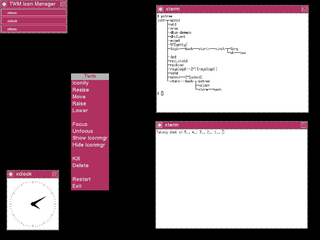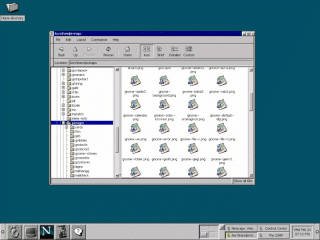
The Common Desktop Environment (CDE) is a desktop environment for Unix and OpenVMS, based on the Motif widget toolkit. It was part of the UNIX 98 Workstation Product Standard, and was for a long time the Unix desktop associated with commercial Unix workstations. It helped to influence early implementations of successor projects such as KDE and GNOME, which largely replaced CDE following the turn of the century.

The X Window System is a windowing system for bitmap displays, common on Unix-like operating systems.

HP-UX is Hewlett Packard Enterprise's proprietary implementation of the Unix operating system, based on Unix System V and first released in 1984. Current versions support HPE Integrity Servers, based on Intel's Itanium architecture.

In computing, a windowing system is a software suite that manages separately different parts of display screens. It is a type of graphical user interface (GUI) which implements the WIMP paradigm for a user interface.

GNOME Display Manager (GDM) is a display manager for the windowing systems X11 and Wayland.

KDE Display Manager (KDM) is a display manager developed by KDE for the windowing systems X11.

twm is a window manager for the X Window System. Started in 1987 by Tom LaStrange, it has been the standard window manager for the X Window System since version X11R4. The name originally stood for Tom's Window Manager, but the software was renamed Tab Window Manager by the X Consortium when they adopted it in 1989. twm is a stacking window manager that provides title bars, shaped windows and icon management. It is highly configurable and extensible.
X.Org Server is the free and open-source implementation of the X Window System (X11) display server stewarded by the X.Org Foundation.
Keith Packard is a software developer, best known for his work on the X Window System.

Visual User Environment is a discontinued desktop environment developed by Hewlett-Packard, intended for use on Unix workstations. VUE is based on the Motif widget toolkit and targets the X Window System.

In Unix computing, CTWM is a stacking window manager for the X Window System in the twm family of window managers. It was created in 1992 by Claude Lecommandeur of EPFL from the source code for twm, which he extended to allow for virtual desktops ; the project is currently (2024) maintained by Matthew Fuller. CTWM has been the default desktop environment for NetBSD since 2020, replacing twm.
In computing, the X Window System is a network-transparent windowing system for bitmap displays. This article details the protocols and technical structure of X11.

In the X Window System, an X display manager is a graphical login manager which starts a login session on an X server from the same or another computer.

OpenWindows is a discontinued desktop environment for Sun Microsystems workstations which combined a display server supporting the X Window System protocol, the XView and OLIT toolkits, the OPEN LOOK Window Manager (olwm), and the DeskSet productivity tools; earlier versions of OpenWindows also supported the NeWS protocol. It implements the OPEN LOOK GUI specification.

Xpdf is a free and open-source PDF viewer and toolkit based on the Qt framework. Versions prior to 4.00 were written for the X Window System and Motif.

IRIX Interactive Desktop is a discontinued desktop environment normally used as the default desktop on Silicon Graphics workstations running IRIX. The IRIX Interactive Desktop uses the Motif widget toolkit on top of the X Window System found on most Unix systems. The default window manager on the IRIX Interactive Desktop is 4Dwm.

Linux is a family of open-source Unix-like operating systems based on the Linux kernel, an operating system kernel first released on September 17, 1991, by Linus Torvalds. Linux is typically packaged as a Linux distribution (distro), which includes the kernel and supporting system software and libraries, many of which are provided by the GNU Project. Many Linux distributions use the word "Linux" in their name, but the Free Software Foundation uses and recommends the name "GNU/Linux" to emphasize the use and importance of GNU software in many distributions, causing some controversy.
A desktop environment is a collection of software designed to give functionality and a certain look and feel to an operating system.

LightDM is a free and open-source X display manager that aims to be lightweight, fast, extensible and multi-desktop. It can use various front-ends to draw the user interface, also called Greeters. It also supports Wayland.

GNOME 1 is the first major release of the GNOME desktop environment. Its primary goal was to provide a consistent user-friendly environment in conjunction with the X Window System. It was also a modern and free and open source software alternative to older desktop environments such as the Common Desktop Environment (CDE), but also to the K Desktop Environment (KDE). Each desktop environment was built-upon then proprietary-licensed widget toolkits, whereas GNOME's goal from the onset, was to be freely-licensed, and utilize the GTK toolkit instead.

















